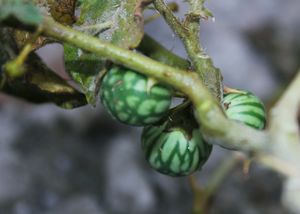Note: This is a project under development. The articles on this wiki are just being initiated and broadly incomplete. You can Help creating new pages.
Alhagi maurorum - Yavasa
Alhagi maurorum is a species of nightshade native to Asia (Saudi Arabia, Yemen, Afghanistan, Iran, China, Bangladesh, India, Nepal, Pakistan, Sri Lanka, Myanmar, Thailand, Vietnam, Indonesia, Malaysia), and is adventive in Egypt. It is a medicinal plant used in India, but the fruit is poisonous.
Contents
- 1 Uses
- 2 Parts Used
- 3 Chemical Composition
- 4 Common names
- 5 Properties
- 6 Habit
- 7 Identification
- 8 List of Ayurvedic medicine in which the herb is used
- 9 Where to get the saplings
- 10 Mode of Propagation
- 11 How to plant/cultivate
- 12 Commonly seen growing in areas
- 13 Photo Gallery
- 14 References
- 15 External Links
Uses
Rheumatism, Piles, Glandular tumors, Nasal polyps, Skin eruptions, Blotches, Pimples, Diarrhea, Hemorrhoids
Parts Used
Chemical Composition
Alkaloid, phytosterols, Glucose, Mannitol[1]
Common names
| Language | Common name |
|---|---|
| Kannada | Nelagulla, Kiragulla |
| Hindi | Katai, Katali, Ringani, Bhatakataiya, Chhotikateri |
| Malayalam | Kantakari chunda |
| Tamil | Kandangatri, Kandankatri, Kandanghathiri |
| Telugu | Nelamulaka, Pinnamulaka, Mulaka, Chinnamulaka, Vakudu |
| Marathi | Bhauringani, Kataringani |
| Gujarathi | Bharingani |
| Punjabi | Kandiari |
| Kashmiri | Kath |
| Sanskrit | Vyaagri, Nidigdhikaa, Dhavani, Kantakarika |
| English | Febrifuge plant |
Properties
Reference: Dravya - Substance, Rasa - Taste, Guna - Qualities, Veerya - Potency, Vipaka - Post-digesion effect, Karma - Pharmacological activity, Prabhava - Therepeutics.
Dravya
Rasa
Tikta (Bitter), Kashaya (Astringent), Madhura (Sweet)
Guna
Laghu (Light),Ruksha
Veerya
Ushna (Heat)
Vipaka
Katu (Pungent)
Karma
Prabhava
Habit
Identification
Leaf
| Kind | Shape | Feature |
|---|---|---|
| Simple | entire leaves are oval to lance shaped and are alternate along the stem |
Flower
| Type | Size | Color and composition | Stamen | More information |
|---|---|---|---|---|
| Unisexual | (2.5 to 5 cm) in length | Yellow | 5-20 | Small, pealike flowers are produced in June to August. These brown to maroon flowers extend from sharp, yellow spines that are 1 to 2 in. (2.5 to 5 cm) in length and located along the rigid branches |
Fruit
| Type | Size | Mass | Appearance | Seeds | More information |
|---|---|---|---|---|---|
| simple | 7–10 mm (0.28–0.4 in.) long pome | Seedpods are constricted between the individual reddish brown to tan seeds and are tipped with small beak | Camelthorn spreads mainly from rhizomes | many | {{{6}}} |
Other features
List of Ayurvedic medicine in which the herb is used
- Vishatinduka Taila as root juice extract
Where to get the saplings
Mode of Propagation
How to plant/cultivate
Requires a sunny position in a well-drained light or medium soil[3]
Commonly seen growing in areas
Edges of ditches, waste and often saline place, dry barren places.
Photo Gallery
References
External Links
- Ayurvedic Herbs known to be helpful to treat Rheumatism
- Ayurvedic Herbs known to be helpful to treat Piles
- Ayurvedic Herbs known to be helpful to treat Glandular tumors
- Ayurvedic Herbs known to be helpful to treat Nasal polyps
- Ayurvedic Herbs known to be helpful to treat Skin eruptions
- Ayurvedic Herbs known to be helpful to treat Blotches
- Ayurvedic Herbs known to be helpful to treat Pimples
- Ayurvedic Herbs known to be helpful to treat Diarrhea
- Ayurvedic Herbs known to be helpful to treat Hemorrhoids
- Herbs with Dried Folaige used in medicine
- Herbs with Whole herb used in medicine
- Herbs with common name in Kannada
- Herbs with common name in Hindi
- Herbs with common name in Malayalam
- Herbs with common name in Tamil
- Herbs with common name in Telugu
- Herbs with common name in Marathi
- Herbs with common name in Gujarathi
- Herbs with common name in Punjabi
- Herbs with common name in Kashmiri
- Herbs with common name in Sanskrit
- Herbs with common name in English
- Habit - Perennial shrub
- Index of Plants which can be propagated by Seeds
- Index of Plants which can be propagated by Cuttings
- Herbs that are commonly seen in the region of Edges of ditches
- Herbs that are commonly seen in the region of waste and often saline place
- Herbs that are commonly seen in the region of dry barren places
- Herbs





